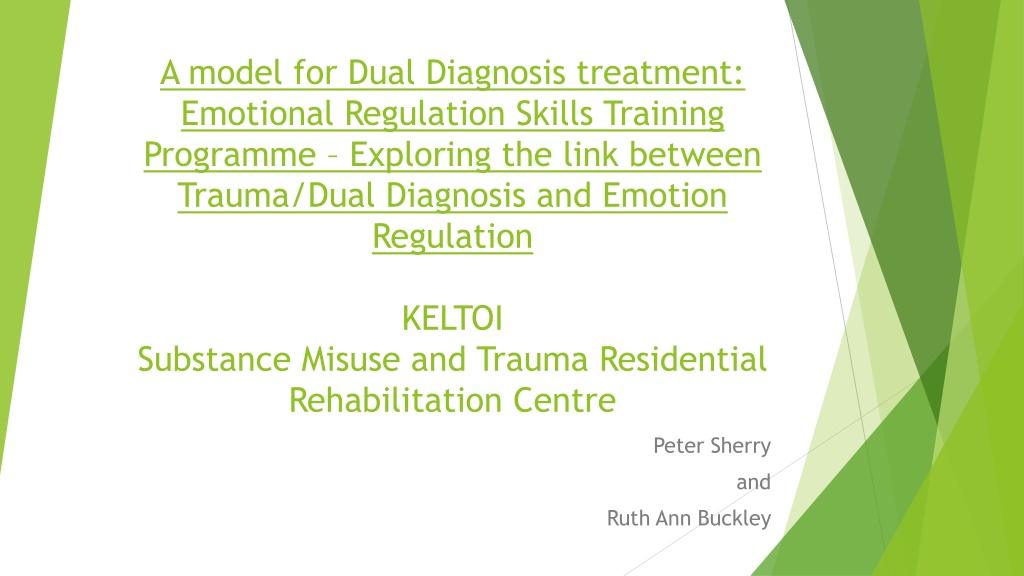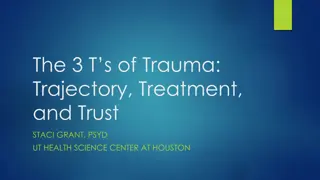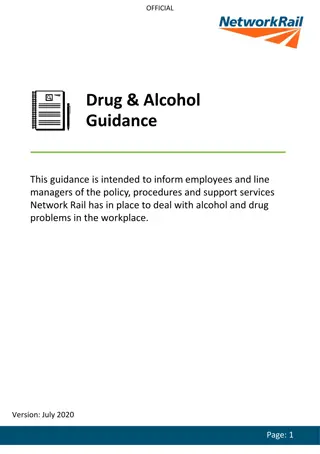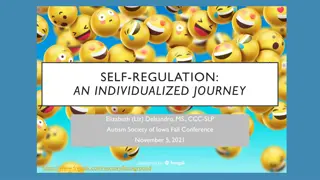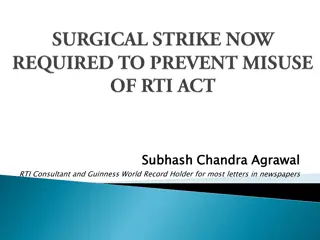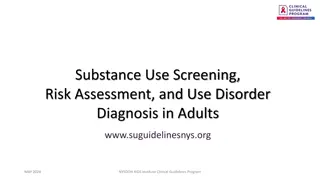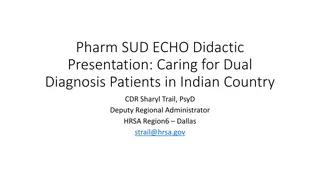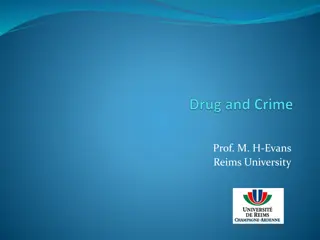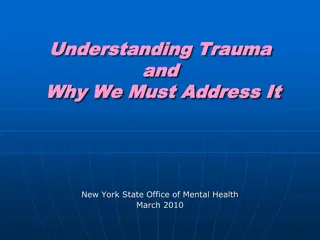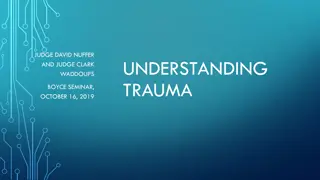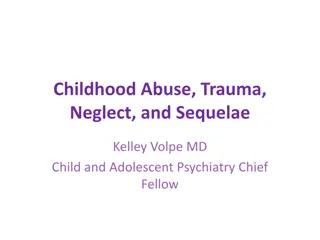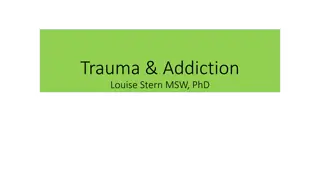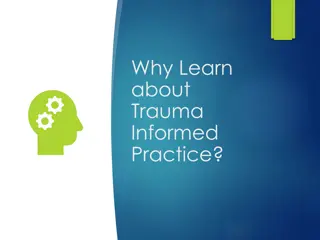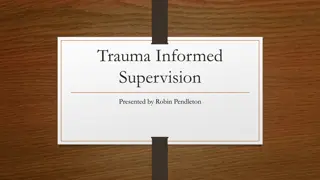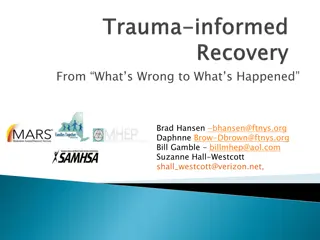Exploring the Link Between Trauma, Dual Diagnosis, and Emotional Regulation in Substance Misuse Treatment
The Emotional Regulation Skills Training Programme at Keltoi Treatment Model focuses on addressing the complex relationship between trauma, mental illness, and substance misuse. Challenges in treating trauma and substance misuse are highlighted, emphasizing the importance of addressing both issues for better outcomes. Dual Diagnosis, defined as the co-existence of mental health and substance misuse problems, is discussed along with the significance of emotional regulation in managing emotionally charged states. Emotion dysregulation is identified as a common factor in various psychiatric diagnoses.
Uploaded on Oct 07, 2024 | 1 Views
Download Presentation

Please find below an Image/Link to download the presentation.
The content on the website is provided AS IS for your information and personal use only. It may not be sold, licensed, or shared on other websites without obtaining consent from the author. Download presentation by click this link. If you encounter any issues during the download, it is possible that the publisher has removed the file from their server.
E N D
Presentation Transcript
A model for Dual Diagnosis treatment: Emotional Regulation Skills Training Programme Exploring the link between Trauma/Dual Diagnosis and Emotion Regulation KELTOI Substance Misuse and Trauma Residential Rehabilitation Centre Peter Sherry and Ruth Ann Buckley
Keltoi Treatment 2018 Drug misuse is viewed as an inability to self soothe; hence, the development of the Emotional Regulation Skills Training Programme Keltoi Treatment Model Trauma Informed Approach Emotional Regulation Skills Training Life Skills CBT Seeking Safety Therapy Mindfulness Somatic Experiencing
Some of the challenges in the treatment of Trauma/Mental Illness and Substance Misuse The relationship between trauma and substance misuse is significant, complex and often mutually reinforcing. Clients present with difficulties including mental illness, PTSD. Substances often form part of the trauma cycle. Outcome studies show that clients with Trauma and Substance use have poorer outcomes with substance misuse interventions if the trauma is not also addressed. Misidentified or misdiagnosed trauma related symptoms interfere with help seeking, hamper engagement in substance misuse treatment, lead to early dropout and make relapse more likely.
Defining Dual Diagnosis The co-existence of both mental health and substance misuse problems including both drugs and alcohol (Royal College of Psychiatry 2002). Prof Doug Sellman (NZ National Addiction Centre); 2010 stated it is somewhat unusual to encounter a person presenting to outpatient addiction services with addiction problems alone. It is the rule rather than the exception that they would have a co-morbid mental disorder .
Defining Emotional Regulation. Emotional regulation incorporates individuals attempts to manage their emotionally charged states such as; low mood, anxiety, depression, stress, PTSD and positive or negative affect. Gratz & Roemer (2004) referred to emotion regulation as the ability to experience, modulate and respond effectively to emotions.
Emotion Dysregulation and Dual Diagnosis. Difficulties with emotion regulation characterise the vast majority of the diagnosis categories of psychopathology in the DSM-V (American Psychiatric Association 2013). For example, in substance abuse, borderline personality disorder and post -traumatic stress disorder, emotional regulation difficulties are seen as pervasive. Fox et al (2008) carried out one of the first studies looking at the link between emotion regulation difficulties in early abstinence for alcohol dependency. Their findings suggested that patients suffering from alcohol dependency had a more pronounced problem with emotion regulation when compared with a control group of social drinkers.
Observations in Keltoi In the treatment of substance dependent persons with mental illness and/ or a history of trauma, it was observed that many residents displayed behaviours of a disconnected nature through hyper or hypo arousal states. Through clinical dialogue, case studies and collaborative therapeutic engagement with our clients, it became clear that these behaviours were related to the challenge of tolerating certain emotions without the use of a substance. Qualitative research was conducted with clients of their experience of making use of a conceptual model for teaching emotional regulation
Development of Trauma Informed/Dual Diagnosis Programme. Emotional Regulation Skills Training Programme (ERST). The Key aspects of this Programme are; Using the Window of Tolerance (Dan Siegel) as a conceptual model for self-monitoring of emotion regulation. Viewing emotions as part of a bundled experience made up of thinking, feeling, body sensation and behaviour. Finding a balance in auto and relational regulation skills. Mindful awareness noticing your body and where you are within your Optimal Window of Tolerance Development of individualised coping strategies for managing emotional dysregulation Grounding and breathing techniques
Development of Trauma Informed/Dual Diagnosis Programme. Conceptual Model Window of Tolerance
Development of Trauma Informed/Dual Diagnosis Programme. Check- in Sheet: Self-Monitoring
Development of Trauma Informed/Dual Diagnosis Programme. Check- in Sheet: Self-Monitoring
Emotional Regulation Skills Training (ERST) programme research findings A qualitative piece of research was conducted Interviews - Thematic analysis of the experiences of a group of Keltoi aftercare clients who had participated in the ERST programme. This piece of research was a pilot study for its introduction into the Keltoi residential programme. The research findings pointed to How emotional dysregulation featured largely as a contributory factor for participants decisions to use drugs. Other contributory factors were Attachment issues, Distress intolerance, Low self-esteem There was a consensus amongst all participants of the positive benefits from the programme in relation to emotional regulation skills development.
Emotional Regulation Skills Training (ERST) programme research findings A further significant finding was that participants spoke of never developing a language to describe how they were feeling. Furthermore, participants pointed to how the development of a language for describing emotions impacted on their normalisation of emotions that had, in the past, caused them to feel abnormal and often led them to relapse. Participants experience of hyper arousal related to hyper-vigilance, impulsivity and anger Participants experience of hypo arousal related to depression and disassociation Impact of the programme on participants; Progress marked increase in self-esteem, self-regulation, normalisation of emotions and increased quality of life Internalisation having a map or a matrix Resources coping skills for managing emotions
Key Learning from the implementation of the ERST Programme A strength of this intervention is its capacity to be delivered in different formats for example groups, one to one setting and peer support mentoring. Training in this programme was rolled out for free for staff working within the addiction service and other HSE funded community services. The programme when given to staff as a self-care tool or used in clinical supervision, has the potential to reduce sick leave and encourage better mental health and wellbeing. This programme/project aims to equip clients to better tolerate and manage their emotions hence reducing relapses on alcohol and drugs.
Key Learning from the implementation of the ERST Programme Some specific challenges were encountered in the delivery of the Emotional Regulation Skills Training Programme (ERST). When the ERST Programme was rolled out in different Addiction/Mental Health and community based settings the programme needed to be adapted to suit the specific timeframes and /or clinical settings for example stabilisation, detoxification, residential, day programme and community peer support projects.
Future Plans for the implementation of the ERST programme Further research of the model in its effectiveness for the treatment of Dual Diagnosis for example Substance Misuse and Depression, Anxiety, PTSD and Complex Trauma. Expand the use of the model to include working with families. Utilise as an assessment tool for those seeking treatment for substance dependency with mental illness and/or a history of trauma A further aim of Keltoi, as a result of the development and roll out of the ERST programme, is to establish an Education, Training and Research College. Mobile App is in the development stages, the application aims to help clients identify potential triggers and would be programmed to suggest emotional regulation resources.
